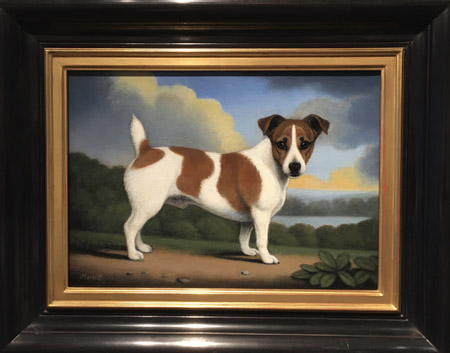
Jack Russell Terrier
|
|
The Jack Russell was bred by Rev. John (Jack) Russell in the first half of the nineteenth century, and the dogs that he and others bred in effect became the working Fox Terriers of the last century. At the time of his death he was considered the oldest Fox Terrier breeder in England. Today he is of course best known for starting the strain of Fox Terrier that bears his name. He started breeding a new type of Fox Terrier when he was eighteen, a type that is now known as the Jack Russell Terrier. Perhaps their most distinguishable feature at the time was their size, for most of them weighed no more than fifteen pounds and many were less. Jack Russell also insisted that they be good working Terriers. There is some mystery behind the bloodlines of the Jack Russell Terrier. The story goes that a bitch named Trump, was purchased from Rev. Russell's milkman. The following account comes from the Rev. E.W.L. Davies' 1862 biography, A Memoir of the Rev. John Russell, and tells of young John Russell, an undergraduate at Oxford, who was taking a walk in May of 1819, when, "...a milkman met him with a terrier - such an animal as Russell had only yet seen in his dreams; he halted, as Actaeon might have done when he caught sight of Diana disporting in her bath; but unlike the ill-fated hunter, he never budged from the spot till he had won the prize and secured it for his own." Whatever Trump's role may have been as progenitor of today's Terriers, her significance in the life of her master is indisputable. Following Russell's death in 1863, his estate either bequeathed or sold his favorite oil painting of the dog to the Prince of Wales, for Russell had close personal ties with the Prince and Princess of Wales, visiting them often at Sandringham. Ever since, Trumps portrait has hung in the tack room at Sandringham. Russell stressed function over the form of a dog, or as the Terrier expert Rawdon Lee has stated, Russell claimed that a "dog with one short leg and three long ones was no eyesore - so long as it could work properly." In parallel movements from about 1860 the Fox Terrier became a popular and important addition to the show ring, while at the same time being kept by fanciers such as the Rev. Russell, for its working abilities with the badger, the otter, the fox and the water rat. According to one fancier, Mr. Reginald Bates, the working Terrier should "stand on "short" legs, have a thick skin, good rough weather resisting coat, and last but not least, a big heart in a little body. A white dog is by far the best, especially when working with fox or otter hounds." Today's Jack Russells are said to descend directly from the original strain propagated by Rev. Russell. Arthur Heineman, for instance, maintained a fine kennel of hunt Terriers whose pedigrees are traced back to Russell's original strain. He was the organizer of The Devon and Somerset Badger Club in 1894, a group that subsequently changed its name to The Parson Jack Russell Club and remained active until after the founder's death in 1930. Other specialty clubs that stage "digs" and shows have come into existence. Although the Rev. Jack Russell was never a devotee of dog shows or show type Terriers, he was a member of The Kennel Club from its founding in 1873 until his death. He also judged Fox Terriers and attended bench shows, but he always decried the stressing of "fancy points" over working ability. |
Home | About
the WS Gallery | Current
Exhibition | New
Additions | Search Our Inventory
| Commissioning Paintings | 19th
& 20th Century Oils | Contemporary
Artists | Works
on Paper & Collectibles | Books
| Christine Merrill
| Guest book | Email
Us
All images, designs and information on this site
are fully copyrighted © 1999
and may not be reproduced of used in any form or any manner, or displayed in
any way
on any website without the express written consent of The William Secord Gallery,
Inc.
William Secord Gallery, Inc.
29 West 15th Street 4th floor
New York, NY 10011
Between Fifth and Six Avenues
www.dogpainting.com
wsecord@dogpainting.com
Tel. 212-249-0075
212-249-0896
By appointment
